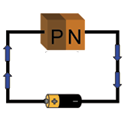Electronics without solids
In the emerging field of atomtronics, theorists imagine analogs of standard electronic circuit elements made from ultracold atoms moving in an optical lattice—an array of potential energy wells created by lasers. The idea is to someday use such a circuit to study basic many-body physics in a completely controlled and adjustable system, without the messiness of crystal defects or impurities found in real semiconductors.
There have been several proposals for atomtronics components. Now, writing in Physical Review Letters, Ronald Pepino, John Cooper, Dana Anderson, and Murray Holland from JILA at the University of Colorado, US, propose complete atomtronic circuits, including new concepts for a diode, transistor, and battery.
The team’s idea for a diode circuit consists of a pair of potential wells in the middle of an infinite one-dimensional optical lattice. If the right well is shallower than the left well by an amount equal to the interaction energy for an atom pair, then atoms can cross from left to right in a “forward bias” configuration. However, no current flows when the “voltage” is reversed. The “voltage” is provided by having a greater reservoir of atoms on one side of the diode than the other.
The team also describes an atomtronic transistor consisting of three wells—two shallower ones flanking a deeper one that is in contact with a third reservoir. They show that small changes in current to this reservoir lead to large changes in left-to-right current—in other words, the transistor can amplify. Holland and his colleagues hope to extend these studies to more complex circuits, such as digital logic elements. – David Ehrenstein





